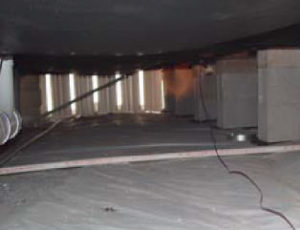 Mobile homes, also known as manufactured homes, have become increasingly popular as an affordable housing option. These homes are built in a factory and then transported to their final location. One important component of a mobile home is its underbelly, a protective covering located beneath the floor. In this article, we will explore the purpose and significance of a mobile home underbelly, shedding light on its crucial role in maintaining the structural integrity and functionality of these dwellings.
Mobile homes, also known as manufactured homes, have become increasingly popular as an affordable housing option. These homes are built in a factory and then transported to their final location. One important component of a mobile home is its underbelly, a protective covering located beneath the floor. In this article, we will explore the purpose and significance of a mobile home underbelly, shedding light on its crucial role in maintaining the structural integrity and functionality of these dwellings.
- The underbelly of a mobile home refers to the protective layer located underneath the floor structure. It serves as a barrier between the interior of the home and the elements beneath it. Typically, the underbelly is made up of a combination of materials such as polyethylene sheeting, insulation, and protective fabric. This composition provides a variety of benefits that contribute to the overall functionality and longevity of the mobile home.
- Insulation and Energy Efficiency:
One of the primary purposes of a mobile home underbelly is to provide insulation. By incorporating insulation material within the underbelly, it helps to regulate the internal temperature of the home. This insulation prevents excessive heat or cold from permeating through the floor, thereby improving energy efficiency. With an adequately insulated underbelly, mobile homes can maintain a comfortable indoor environment throughout the year, reducing the need for excessive heating or cooling.
- Protection from Moisture and Condensation:
Mobile homes are vulnerable to moisture-related issues, such as condensation, humidity, and water infiltration. The underbelly acts as a protective barrier against these threats. The polyethylene sheeting, which is often a part of the underbelly, acts as a moisture barrier, preventing water from seeping into the floor structure. It also helps to mitigate the risk of condensation, which can lead to mold, mildew, and rotting. By effectively sealing off the underfloor area, the underbelly ensures the longevity of the home and maintains a healthy living environment.
- Structural Support and Durability:
In addition to insulation and moisture protection, the underbelly contributes to the structural integrity and durability of a mobile home. It serves as a protective shield against pests, rodents, and debris that may find their way underneath the home. The materials used in the underbelly construction are chosen for their strength and resistance to wear and tear. This reinforcement helps to support the floor structure, preventing sagging or weakening over time. Moreover, the underbelly provides an added layer of stability during transportation and relocation of the mobile home.
- Plumbing and Electrical Systems:
Mobile homes require plumbing and electrical systems that run beneath the floor. The underbelly offers an organized and protected space for these utilities. By enclosing these components, the underbelly safeguards them from external damage and prevents them from being exposed to the elements. This arrangement also makes maintenance and repairs more accessible, as technicians can access the systems through designated access points in the underbelly.
Conclusion:
A mobile home underbelly plays a vital role in maintaining the functionality, efficiency, and longevity of these dwellings. It provides insulation, protects against moisture and condensation, supports the structure, and houses plumbing and electrical systems. Investing in a high-quality underbelly and ensuring its proper maintenance is essential for mobile homeowners to enjoy a comfortable living environment while protecting their investment.
As the demand for mobile homes continues to rise, understanding the significance of the underbelly allows homeowners to make informed decisions about maintenance and repairs, ensuring their homes remain safe, durable, and energy-efficient for years to come.
Mobile homes have become increasingly popular as an affordable and flexible housing option for many individuals and families. These structures are built with specific features to ensure durability and comfort. One crucial component of a mobile home is its underbelly, a protective layer that serves multiple purposes. In this article, we will explore the importance and functions of a mobile home underbelly, shedding light on its role in maintaining structural integrity and enhancing energy efficiency.
- The mobile home underbelly refers to the protective layer that covers the floor insulation and the mechanical systems installed underneath the structure. It typically consists of a moisture barrier, insulation materials, and a protective covering. The materials used may vary depending on the manufacturer, climate, and specific requirements of the mobile home.
- One of the primary functions of the mobile home underbelly is to protect the floor insulation from moisture and water damage. The underbelly acts as a barrier against the elements, preventing rain, snow, and groundwater from infiltrating the insulation material. Moisture can lead to mold, mildew, and rot, which can compromise the structural integrity of the mobile home and pose health risks to its occupants.
Additionally, the underbelly helps regulate the internal temperature of the mobile home. Insulation materials within the underbelly create a thermal barrier, reducing heat loss during cold weather and minimizing heat gain during hot weather. This insulation layer helps improve energy efficiency, reducing the reliance on heating and cooling systems and lowering utility costs for mobile homeowners.
- Protection Against Pests and Animals, The underbelly also serves as a safeguard against pests and animals. By creating a sealed and secure barrier, it prevents rodents, insects, and larger animals from entering the mobile home’s crawl space. Without proper protection, these intruders can cause damage to insulation, electrical wires, plumbing, and other vital components. The underbelly, therefore, acts as a deterrent, maintaining the integrity of the mobile home and ensuring a comfortable living environment.
- Structural Support and Stability: In addition to moisture and insulation control, the mobile home underbelly provides structural support and stability. It reinforces the floor system, preventing sagging and maintaining the overall integrity of the structure. The underbelly materials, such as vinyl or plastic, help distribute the weight evenly across the floor joists, reducing the risk of uneven settling or damage due to excessive load.
Furthermore, the underbelly protects the mobile home’s plumbing and electrical systems that are routed beneath the floor. It shields these vital components from accidental damage and exposure to the elements, preserving their functionality and ensuring the safety of the occupants.
- Maintenance and Repairs: Regular inspection and maintenance of the mobile home underbelly are essential for its proper functioning. Over time, the underbelly material may develop cracks, tears, or holes, compromising its effectiveness. It is crucial to identify and repair such damage promptly to prevent moisture infiltration and maintain insulation efficiency. Mobile homeowners should regularly inspect the underbelly for signs of wear and tear and consult professionals if repairs are needed.
The mobile home underbelly is a critical component that provides various functions to enhance the durability, energy efficiency, and overall comfort of these structures. It acts as a moisture barrier, regulates temperature, protects against pests, and provides structural stability. Mobile homeowners should prioritize regular maintenance and inspection of the underbelly to ensure its longevity and optimal performance. By understanding the importance of the underbelly, individuals can appreciate the significant role it plays in the overall functionality and lifespan of their mobile homes.
